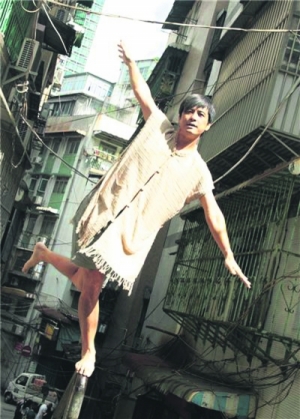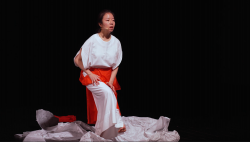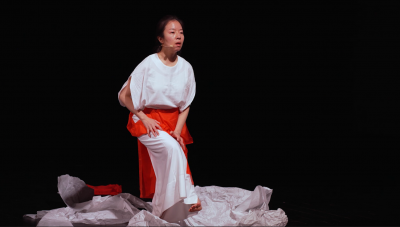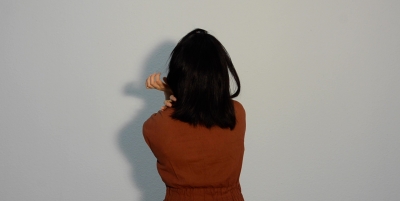2023年9月
I am not researching. I am practicing. I become a body.
—Eiko Otake, in conversation with Rosemary Candelario
1
I am an artist, and I create a sonic and visual space through my art of voice and body, using my sung voice, body movement, and spoken words. In 2021, I started to take my shoes off for many of my performances. This choice, which initially was to sense my movement and floor more and be able to nurture my sensibility, led to my inquiry about feet. I lied on the floor and performed, focusing on leg movements of my grandfather a few weeks before his passing, those of a new-born infant I saw at a hospital, and my own healing process, moving my legs and bare feet. My feet, which had seemed so far from my head and my mind regardless of the fact that I must have licked my feet as a baby, moved by themselves. My feet, body, and voice told time-transcending stories through my site-specific presence. How did the bare feet impact my performance, and what is the relationship between the revealing portions, whether these are feet or hands, and the clothed portions of body, and what are their relations to body and voice? Several later works gradually unpacked these questions.
Aine Nakamura shows leg movements of her grandfather and an infant in Shape (Photo by Ayaka Fuiji, Courtesy of Aine Nakamura)
Before looking closely at two examples of my performance, I would like to think about naked body and what revealing skin means. Becoming naked is a private, vulnerable, and sensual moment in our everyday lives. It is private—it is in between changing our clothes, in other words, changing our modes in lives, completely free from either mode. It makes us vulnerable—if the earthquake happens, for example, we would probably try to wear something that is near our bodies before escaping so as not to expose our naked bodies. It is sensual—it is a moment when we see our own skins and most body parts to the extent our eyes can see, and possibly connect with bodies, and listen to how they feel and how they are.
In Sons of Sissy by Simon Mayer, naked performing bodies and their movements create the performance and sounds. I was surprised by how the performing naked bodies and skin themselves became storytellers (2023, Sibiu International Theatre Festival). By clapping on and tapping the skins, redness of the skins appeared, and by running around in naked bodies and jumping, which made rhythmic sounds, with penises constantly moving up and down, muscularity was destroyed, and fragility appeared. Dancer Min Tanaka whose costume was his naked and shaved body, covering only his penis with a cloth, writes in Boku wa zutto hadaka datta (I have always been naked) as follows.
It was me who was embarrassed to death. But, it needed to happen because I thought I needed to do it. […] I was thinking, finally, I may be able to live freely. […] Choosing and deciding to be naked affected every part of my life afterwards, and the naked body gave me a key to think about dance. […] Naked-body butoh is the culmination of moments through flesh and blood. There is no assurance or anything. The core of my being attracted to, possessed by, struggling with, and doubting dance was about continuing to think about what to dance and how to live. This is not a principle, idea or decision, but my mind was always saying to live with dance. In other words, it was about ‘how to live.’ (20-24)
Tanaka eventually changed his costume from naked body to a raincoat, “not as a cloth to hide the naked body, but as a material that allowed [him] to maintain [his] feelings of skin.” (43) From Mayer’s work and Tanaka’s work, what can be noticed is that choosing naked body as costume means to let the skin and nude have their own agencies, and performing with the continuing question of what body and dance are, while risking to reveal privacy, vulnerability, and sensuality; the risk itself becomes a story.
Takaaki Yoshimoto describes in his theory of fashion in High Image Theory I the contour lines and potential sight lines in nudes, upon considering nudes as costumes. Yoshimoto points out that the lines’ directions and qualities change across junction lines, which correspond with borders of costumes/clothes (48-49). Yoshimoto further writes that 頭部 head, 手 arms and hands, and 足 legs and feet have unique and separate meanings in “nudes as costumes.” Each of the three parts, head, arms, and legs, creates an independent nude within a naked body. This theory seems to apply to body parts that come out of clothing as well. Revealed parts start to have meanings different from the clothed body parts.
I have noticed through my performances Yami and Iro (2023, Berlin University of the Arts), and Untitled/Under a cherry tree from Circle hasu We plant seeds in the spring of mountains (2021-22, The Gallatin Galleries, and Theatertreffen at Berliner Festspiele), how bare feet and hands move in relation to edge lines of garment while the clothed body part maintains its core and balance. Architectural historian and architect Kazuaki Seki wrote to me, in our correspondences and in response to my thought that costumes may be like houses and buildings for bodies, edge lines can be considered as 開口部 opening parts just like windows and doors of buildings. In Yami and Iro, which focused on authorship of body and sensuality, out of the window, or the hemline of my familial kimono undergarment (wrapped cloth), I moved my foot one at a time. Balancing myself with another foot and other parts of my body, and moving my foot as if I reach for poetic and fragile space of, in, and outside of my feet, I would sense slightly the touch of the garment. I knew that the audience too was seeing my focus on my feet and the garment.
The ambiguity of the constantly moving edge line and drapes of the wrapping skirt gave nuances to the action and my voice, which waited for and listened to what feet might find. My improvised and sung voice would not rush, it would not become loud. It would delicately tell, together with the moving feet, my sensitive and private poetics and sensibility. The moving edge line, the body, and the voice were not separate.
Still image from video documentation of Yami and Iro by Anna Petzer (Courtesy of Aine Nakamura)
Rahaim points out in Musicking Bodies that music cannot be reduced to sound, and voice and body are intertwined. Focusing on vocal and bodily gestures in North Indian music, Rahaim writes, “[m]elodic gesture embodies a special kind of musical knowledge, transmitted silently from body to body alongside the voice.” “Hidden within the throat and skull, musical knowledge embodied in physical action is transmitted […] through teaching lineages.” (3-6) In new arts like mine however, which does not focus on transmitting musical or dance knowledge, what is appearing in the motion in relation to voice and vice versa?
Multidisciplinary artist Eiko Otake says in an interview by Rosemary Candelario as follows. “The choreographic process has so much happenstance. A decision does not always come from knowledge, but sometimes rather from the tactical, strategic, or emotional ways we happen to make a piece.” (100) Talking about her work with Koma, Fur Seal (1977), she says, “our desire was to create something that challenged the gendered choreography and vocabulary of modern dance, ballet, and traditional Japanese dance.” For her, “art-making does not have to be knowledge production.” “I become a body.” (95-97) What appears is constantly in motion and it cannot be defined in one place or term. It can only “become” upon performance and through witnessing it.
In my aforementioned work Yami and Iro, in the scene of my feet movement, I did not have any melodic or musical structure. I wanted to focus on the sensuality that the feet may find. My vocal choice was not based on what may be considered musically right, surprising, or virtuosic, but on my listening to my skin, my feet, and the moving garment. Now, even without a purpose of transmitting a tradition, we cannot say that the feet, skin, and voice are not in the lineages. The feet have walked many paths, and imagined other feet. The skin has seen lives and deaths, has felt joy and pain, has been exposed to wind and sun, has been sensitive to tension and relaxation, and has been in solitude and in relations. I have called names and I was called. I have spoken languages I learned, trying to find ways to convey. I have cried, my voice making sounds, and I heard my grandmother’s warm voice, which stays in me. Since I was born, or even before I was born, the cells of body embody forgotten memories, waiting for unknown future, and the voice is in search of communication. With these lineages beneath, the feet gained their freedom to seek for poetics and sensuality. And, the vocal decision was based on the listening to and through my feet.
In my performance Untitled/Under a cherry tree, my arms played a significant role. I stood at one location, wearing red familial kimono underwear, (which I had introduced in my previous main performance with my storytelling about familial and personal ethnography). Because I represented a tree in this performance, I did not move my feet and legs, and even my hips, i.e. the bottom part below a belt, the border line of the costume. My hands and parts of my arms that are shown out of sleeves would touch the other hand/arm, as if they gathered memories and sceneries, and weave stories. The sleeves would sway together with the movement. In this work, and in other works, often times, my hands and parts of my arms, or my feet out of sleeves and layers almost feel like different creatures from the clothed parts of my body. The nude portions start to act, move, and follow traces by themselves. And, by hiding, for instance, other parts of legs and arms with clothes, my body and senses focus intensively on the feet and arms that appear from the clothes.
In this work, a simple melody was repeated and would change its texture or timbre, speed, and shape in accordance with the arm/hand movement. The movement gives ample space to my sung voice as my hands and arms listen to the other hand/arm, skin, imagined story, silence, scenery, spatial space, and sounds at the site. This work was inspired by a novel. In other words, language or thinking in language was a part of the creative process. I am astonished by the word “gathering of vibration,” which Ashton T. Crawley mentions in examining James Baldwin’s writing that it is “a gathering of the vibration, the ongoing movement of matter, in the cause of plays, poetry, prose” (19). Narratives and sceneries evoke feelings, senses, memories, unspoken and the “ongoing movement.” My arms, which were in relations with the body lineage and the site, were searching, in time-transcending time flow, for stories by themselves. My voice or song, which was in relation with the arms, gave care to the arms and waited for the arms to listen to each other and to the skin, and to the unspoken. The vibrating diaphragm being covered with clothes, the core of the tree or my body was under control, while I let the gathering and searching lead my arms and voice.
2
I have hidden my face and my front body part in my past two works, of which my vocal and performance choices were drastically different, at least on my artistic decision level, from other works. In Honehitotsu, a 30-minute performance I presented upon the occasion of the exhibition Me, The Timeless Self – within the Umwelt by visual artist Keiko Miyamori (2023, Nokogirini), I wore masks created by Miyamori. The theme of the exhibition was umwelt, each species having a different perception of the environment. Miyamori takes rubbed copies of trees on washi paper and exhibits them. With this theme, and with the request by Miyamori for a performance that would allow audience to feel energy-body, (instead of my personal feelings, backgrounds and identity,) I aimed to connect what may be in between and below surfaces of skins of paper, skins of trees, skins of audience and me, skins of costumes, life, death, unknown, and things, including the embodied weaving tools at the site (which was an old weaving factory, now an art space). By wearing the mask which hid my face, a significant part of my personal identity, I was able to let the abstract and wide environment, and mask itself, instead of identified flesh and body, be the main performing energy. This was a significant change in my art, as I had performed through my identity and embodiment—instead of acting, I had “become” an insect or a flower petal, or an old man or a baby through my embodiments of stories, poetics and feelings. However, under the theme of each species having a different perception, I felt my embodiment from my own senses and feelings seemed self-centered. The mask supported my performing from a different way of centering my performing-self than I had before, which in a way was not mine but was of the performing energy that connects the skins.
In my performance for a video camera Okaasan (2021, Green Hill Gallery Berlin), I faced toward a wall, and showed my back to the video camera, and toward artist Valdrin Thaqi who rolled the video and visual artist Aloe Corry who captured my movements through her drawing. Okaasan means mother in Japanese. I used words and sung voice that I would be embarrassed to use in my daily life but would like to convey to my mother before the end of the day. The camera shot the upper part of my body from around the waist to the top of my head. My hair was down, and I was wearing a short sleeve naturally dyed dress. My hands and arms moved out of the sleeves, as if they touched my mother’s hair and traced memories and unspoken. By not showing my face, facial expression, and mouth, I was not embarrassed at all, and I could be vulnerable as the work needed to be.
Still image from Okaasan's video documented by Valdrin Thaqi (Courtesy of Aine Nakamura)
In both works, just like the previous works introduced, my musical decision was not based on what may be considered surprising or new, but it was always in relation to listening and imagining. In Honehitotsu, one of the approaches I took to center myself to and perform the energy-body was to study eastern philosophy from works by Toshihiko Izutsu. Izutsu writes about the difference between 深層的自己 depth of self, which connects with oneness, and 表層的自我 surface of ego, which is a part of self but would be separated from the depth if it becomes the major portion. This idea gave me a key to how I would perform from an embodying body, but still not through surface of ego. The mask supported my distancing myself from the surface. By digging deep inside the depth instead of giving attention to the surface, I was connected to and performed from the energy between and beneath skin.
My teacher and actor Anna Deavere Smith says that eyes are windows to your soul. She would request her students not to hide and close their eyes with their hair upon performance. If you hide your eyes, people would not see your soul, or more specifically, you would not be able to use your soul as your clear artistic element to reach out to the audience upon performance. In The Race of Sound, Nina Sun Eidsheim introduces in Figures Intro 1 and 2 how the sound waves locate in between the speaker’s or singer’s mouth (and ear, brain, and vocal muscles), and the listener’s ear (and brain) (12-13). However, significant elements are missing from the figures to describe listening–the eyes. What are the listener’s eyes looking at, and how is the speaker or singer noticing how one is being looked at or not looked at, either live or through a screen, or without any screen, are important factors in what kinds of voice and performance the performer may choose and create. I was able to speak to my mother via the camera in the most vulnerable way because I was showing my back, hiding and without caring about my face expression I was making. I was not bound by what surface I should have and what voice I should use. One of the audiences who saw my performance with the mask said that it was as if the sung voice came from the site and not from the performing body. My performing body and voice were in service of the whole site and energy. The mask and the visual had a sonic impact for the audience and the performer.
Honehitotsu, mask by Keiko Miyamori (Photo by 花龍, Courtesy of Aine Nakamura)
3
We have looked at how revealing and hiding body portions impact a performing body and audience experience. My questions on costume and clothing, and inner and outer are continuing. Before ending this essay, I would like to introduce several approaches of artists whom I look up to and whose inquiry already starts from the depth.
Etsuko Ohno, the costume designer of Butoh dancers Kazuo Ohno, and Yoshito Ohno, who was my teacher, said to me that a costume should show the body of a performer (if the performer is a dancer). Showing the body does not necessarily mean showing a naked body. In her opinion, costume cannot be the main character, or should not stand out, but the body needs to be the main character. Yoshito Ohno’s main costume was a white puffed long sleeve shirt and white long wide pants, both having drapes as he moved. This was the best costume for him and for Etsuko Ohno to show his performing body, considering how he moved, and how he approached body. Etsuko further says that costume is skin, costume (including nude) becoming and being the skin and body. She mentions about Charlie Chaplin as an example, how his costume that we all know was and made “Chaplin” and how the costume was a part of the “Chaplin’s” body.
Upon considering costume as skin, and a part of body, as Etsuko Ohno and Butoh dancer and educator Yuko Kaseki also mentions, there is another way to consider that costume becomes more actively a performing body and collaborator. Upon Yuko’s performance AMMO-NITE GIG TOKIO Vol.3 in collaboration with sound artist Toshimaru Nakamura (2023, co-oh), her costume, a cloth, was laid on the floor. She came in almost darkness with nude-colored thin leotard, which was almost transparent with calligraphy written on it, crowing over the floor, performing with her flesh, and by the time I noticed, she was in the cloth. The cut cloth is a costume that she has been using since her work TodAncestor (2021, DOCK11), of which theme was death. “It is a bugged clothing, a cloth, which is like burial clothes or ancient clothes, being simply sewn.” Yuko made the cloth as 身體衣 of 迷路, body clothing of labyrinth, putting a long sleeve on the body part of the cloth and making holes, from which she can go out and in. She would turn her body inside the cloth, or turn the cloth, and touch the floor, air and audience with the cloth. It was as if the clothing was her skin and transformable performing body, which would change its shape and expression constantly. When she touched the audience with her hand or when the cloth touched audience, it was ambiguous whether it was her hand or cloth, and it did not matter as there was no clear boundary between the two—her body and cloth were both her performing bodies.
In Worn Worlds: Clothes, Mourning, and the Life of Things, Peter Stallybrass described how he was “inhabited by” his friend Allon’s “presence” through Allon’s jacket that was left after Allon’s death. “If I wore the jacket, Allon wore me. He was there in the wrinkles of the elbows, wrinkles that in the technical jargon of sewing are called ‘memory’; he was there in the stains at the very bottom of the jacket.” The author further writes that “[t]he magic of cloth [...] is that it receives us; receives our smells, our sweat, our shapes even.” (28) Embodiment may be exactly the reason costumes and materials, or nude portions start to have their meanings once a performer performs in and with them. The embodied costumes then create the body together, and continuing embodiment and performance experience together.
What is costume? Through body in costume, what can be cared for? What can be imagined? It seems that these are extremely transformable inquiries, with which performers can work with.
References
Candelario, Rosemary & Otake, Eiko. “Practice (or) Research: A Conversation with Eiko Otake.” Dance Research Methodologies: Ethics, Orientations, and Practices. Edited by Rosemary Candelario and Matthew Henley. New York: Routledge, 2023.
Crawley, Ashon T. Blackpentecostal Breath: The Aesthetics of Possibility. New York: Fordham University Press, 2016.
Eidsheim, Nina Sun. The Race of Sound: Listening, Timbre, and Vocality in African American Music. Durham: Duke University Press, 2019.
Kaseki, Yuko & Nakamura, Toshimaru. AMMO-NITE GIG TOKYO Vol.3. August 15 2023, Art Space 呼応 co-oh, Tokyo.
Mayer, Simon. Sons of Sissy. Performance by Simon Mayer, Matteo Haitzmann, Patric Redl, and Simon Wehrli, Art in Motion, June 24 2023, Studio Hall TNRS, Sibiu.
Nakamura, Aine. Honehitotsu. Performance by Aine Nakamura, August 5 & 6 2023, Nokogirini, Ichinomiya.
Nakamura, Aine. Okaasan. 2021, video, Green Hill Gallery, Berlin.
Nakamura, Aine. Untitled/Under a cherry tree. Performance by Aine Nakamura, July 28 2021 & May 13 2022, The Gallatin Galleries & Berliner Festspiele, New York & Berlin.
Nakamura, Aine. Yami and Iro. Performance by Aine Nakamura, March 2 2023, Berlin University of the Arts, Berlin.
Ohno Kazuo Hyakunen no Butoh (Kazuo Ohno 100-year Butoh). Edited by Kazuo Ohno Dance Studio. Tokyo: Film Art, 2007.
Ohno, Keiko. Text messages to Aine Nakamura. 2019-2023.
Ohno, Yoshito. Flowerbird Butoh: A Way of Life. Tokyo: Canta Co. Ltd, 2015.
Rahaim, Matthew. Musicking Bodies: Gesture and Voice in Hindustani Music. Connecticut: Wesleyan University Press, 2013.
Seki, Kazuaki. “BankArt open studio nite.” Received by Aine Nakamura, July 8 2023.
Kaseki, Yuko. “no title.” Received by Aine Nakamura, September 13 2023.
Smith, Anna Deavere. Course “Performing Narratives.” NYC: New York University, 2019.
Stallybrass, Peter. “Worn Worlds: Clothes, Mourning, and the Life of Things.” Cultural Memory and the Construction of Identity. Edited by Dan Ben-Amos and Liliane Weissberg. Detroit: Wayne State University Press, 1999.
Takaaki, Yoshimoto. High Image Ron I (High Image Theory I). Tokyo: Fukutake Shoten, 1989.
Tanaka, Min. Boku wa zutto hadaka datta (I have always been naked). Tokyo: Kosakusha, 2011.
本網站內一切內容之版權均屬國際演藝評論家協會(香港分會)及原作者所有,未經本會及/或原作者書面同意,不得轉載。












